Why Visiting the Mausoleum of Sun Yat-sen Will Transform Your Understanding of Modern China
An Essential Guide to Visiting Mausoleum Of Sun Yat-Sen
Nestled amidst the lush greenery of Purple Mountain in Nanjing, the Mausoleum of Sun Yat-sen stands as a poignant tribute to the father of modern China. What sets this remarkable site apart is not just its grand architecture, which elegantly marries Eastern and Western design elements, but also its profound historical significance as a symbol of national pride and revolutionary spirit. As you ascend its majestic marble steps, you’re not merely visiting a mausoleum; you’re stepping into a chapter of Chinese history that reshaped the nation.
This guide will take you on a journey through the mausoleum’s awe-inspiring features, from the sweeping views atop the Sacrificial Hall to the serene beauty of the surrounding landscape. You’ll discover the intricate details of the memorial archway, the heartfelt inscriptions that echo the ideals of democracy and unity, and the breathtaking experience of navigating the expansive grounds. Additionally, we’ll provide essential visitor information, including opening hours, ticketing details, and nearby attractions, ensuring you make the most of your visit to this sacred site. Prepare to delve into the legacy of Dr. Sun Yat-sen and uncover the stories that make his mausoleum a must-see destination in Nanjing.
In This Guide
- An Essential Guide to Visiting Mausoleum Of Sun Yat-Sen
- The Rich History and Legends of Mausoleum Of Sun Yat-Sen
- Main Highlights: What You Absolutely Can’t Miss
- Planning Your Visit: A Practical Guide
- Tickets: Prices, Booking, and Tips
- How to Get There: A Complete Transportation Guide
- Local Cuisine and Accommodation Nearby
- Frequently Asked Questions
- Final Thoughts on Your Trip
The Rich History and Legends of Mausoleum Of Sun Yat-Sen
A Tribute to a Revolutionary Icon
Nestled in the lush landscape of Purple Mountain, the Mausoleum of Sun Yat-sen is not just a resting place but a monumental symbol of a pivotal era in Chinese history. As the father of the Republic of China, Sun Yat-sen (1866-1925) played a crucial role in dismantling the centuries-old imperial system, leading the charge against the Qing Dynasty and advocating for a modern, democratic China. His legacy is immortalized in the grand architecture and serene surroundings of his mausoleum, which attracts millions of visitors each year.
The Construction of a National Landmark
The mausoleum’s construction began in 1926, a mere year after Sun Yat-sen’s death, and was completed in 1929. The site was deliberately chosen for its scenic beauty and historical significance, as Nanjing served as the location for the provisional government established after the 1911 revolution. The mausoleum was designed to embody the spirit of Sun’s vision for a new China, featuring a layout resembling an alarm bell from the air—an emblem of vigilance and resilience.
Visitors approach the mausoleum through a majestic marble pathway that leads to the grand entrance, marked by a beautifully crafted memorial archway inscribed with the word “Bo Ai,” which translates to “love.” This setting not only honors Sun Yat-sen’s ideals but also provides a serene environment for reflection.
The Architectural Marvel
The mausoleum itself is a stunning blend of Chinese and Western architectural styles. The main structure, the Sacrificial Hall, rises majestically at 158 meters (518 feet) above sea level and comprises intricate designs that showcase the influences of both cultures. Upon entering, visitors are greeted by a striking 4.6-meter (15-foot) statue of Sun Yat-sen, seated with an open book, symbolizing his wisdom and dedication to the nation.
Surrounding the hall are ornamental columns reminiscent of those found in Tiananmen Square, reinforcing the national significance of the site. The overall design reflects Sun’s aspirations for a unified and prosperous nation, resonating deeply with both domestic and international visitors who pay their respects.
Legends and Legacy
The Mausoleum of Sun Yat-sen is steeped in legends that add to its mystique. One popular tale recounts how Sun Yat-sen expressed his wish to be laid to rest in Nanjing, stating: “After my death, I wish to be buried at the foot of Purple Mountain, as it is the birthplace of the Republic.” This sentiment reflects his deep connection to the city and its role in China’s revolutionary history.
Another legend speaks of the mausoleum’s construction being a race against time. It is said that the workers labored tirelessly, fueled by a collective passion for Sun Yat-sen’s vision. Some believe that the spirits of those who fought for the Republic guide and bless the site, making it a hallowed ground where history and reverence intertwine.
A Symbol of Unity and Hope
Today, the Mausoleum of Sun Yat-sen stands not only as a tribute to a revolutionary leader but also as a symbol of hope and unity for the Chinese people. It invites visitors from around the world to reflect on the ideals of democracy, national independence, and social justice that Sun Yat-sen championed. The mausoleum is more than an architectural masterpiece; it is a living testament to a transformative period in China’s history, reminding us of the enduring legacy of those who dared to dream of a better future.
As you walk through its beautiful grounds and contemplate the life of Sun Yat-sen, you become part of a larger narrative—a story of resilience, aspiration, and the relentless pursuit of a brighter tomorrow.
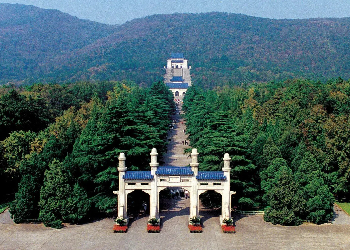
Mausoleum Of Sun Yat-Sen.
Main Highlights: What You Absolutely Can’t Miss
The Grand Entrance: Paifang Archway
As you approach Dr. Sun Yat-sen’s Mausoleum, your journey begins at the magnificent Paifang, or memorial archway. This impressive structure, adorned with the Chinese characters for “Bo Ai” (meaning ‘love’), sets the tone for the reverence of the site. Be sure to take a moment here to capture the beauty of the archway and the surrounding cypress trees. Tip: Arrive early in the morning to avoid crowds and enjoy the tranquil atmosphere.
The Marble Pathway
Walking along the serene 480-meter (about 1,574 feet) marble pathway, flanked by rows of stately pine and cypress trees, you’ll feel a sense of grandeur that honors Dr. Sun Yat-sen’s legacy. This pathway leads you towards the main mausoleum and serves as a beautiful prelude to the historical significance that awaits. Tip: Wear comfortable shoes, as this pathway is just the beginning of a scenic exploration that includes many steps ahead!
Frontispiece: A Symbol of Unity
The Frontispiece, an architectural marvel standing 16.5 meters (about 54 feet) high, greets you with its three majestic archways. Each doorway is flanked by exquisite copper gates and inscribed with Dr. Sun Yat-sen’s profound words: “the world is a commonwealth.” This is a perfect spot for photography, so don’t forget to capture the essence of unity that this inscription represents. Tip: Visit during golden hour for stunning light that enhances your photos.
The Sacrificial Hall: A Fusion of Cultures
Ascend the staircase to the Sacrificial Hall, the highest point of the mausoleum complex at 158 meters (about 518 feet). This stunning structure combines Chinese and Western architectural elements, creating a breathtaking visual harmony. Inside, you’ll find a striking 4.6-meter (15 feet) statue of Dr. Sun Yat-sen, symbolizing his enduring wisdom. Tip: Spend time reflecting in this serene space; it’s both a place of honor and introspection.
The Tomb Chamber: Resting Place of a Revolutionary
Within the Sacrificial Hall lies the tomb chamber, where Dr. Sun Yat-sen’s marble coffin rests beneath a magnificent hemispherical dome. The simplicity of the chamber, with its elegant white marble, pays tribute to the great leader. Pause here to appreciate the profound silence that envelops this sacred space. Tip: Be respectful while visiting; this is a place of remembrance and honor.
Memorial Buildings: A Tribute to Legacy
Surrounding the main mausoleum are several memorial buildings, including the Zhengqi Pavilion and the Open-air Music Hall. These structures provide deeper insight into Dr. Sun Yat-sen’s impact on modern China. The Sun Yat-sen Museum is particularly noteworthy, offering rich historical context through exhibits and artifacts. Tip: Allocate some time to explore these buildings, as they enhance your understanding of Dr. Sun Yat-sen’s revolutionary spirit.
Nearby Attractions: Beyond the Mausoleum
After immersing yourself in the solemn beauty of Dr. Sun Yat-sen’s Mausoleum, consider visiting nearby attractions like the Ming Xiaoling Mausoleum and Linggu Temple. These sites, accessible by a convenient sightseeing bus or battery car, enrich your experience in Nanjing. Tip: Purchase a combo ticket that covers multiple sites for a seamless exploration of this historic area.
Each of these highlights at the Mausoleum of Sun Yat-sen encapsulates the profound respect and admiration that the Chinese people hold for their revolutionary leader. Your visit here will not only educate you about a pivotal figure in history but will also immerse you in the natural beauty of Nanjing’s Purple Mountain.
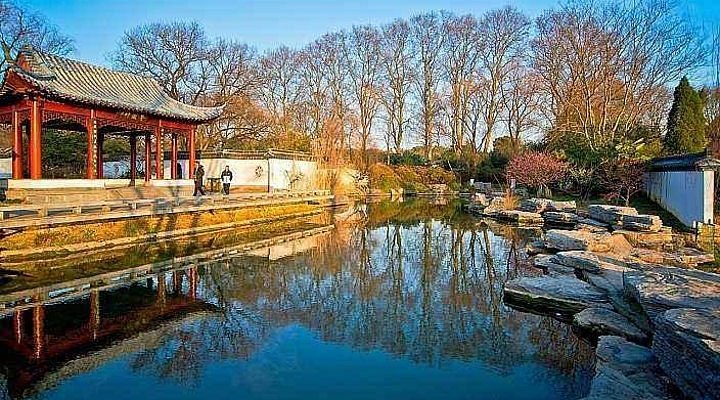
Mausoleum Of Sun Yat-Sen.
Planning Your Visit: A Practical Guide
Best Time to Visit
The Mausoleum of Sun Yat-sen is a year-round attraction, but the best times to visit are during the spring (March to May) and autumn (September to November) months. During these seasons, the weather is mild, and the surrounding landscape is particularly beautiful with blooming flowers in spring and colorful foliage in autumn. Summer can be hot and humid, while winter may bring chilly temperatures, so it’s advisable to dress accordingly if you visit during these seasons.
Recommended Itinerary
To fully appreciate the Mausoleum and its surrounding attractions, consider the following itinerary:
-
Morning: Arrive early to avoid crowds and enjoy the serene atmosphere. Start your visit at the Paifang (Memorial Archway), then stroll along the 480-meter-long pathway lined with pine and cypress trees leading to the Frontispiece.
-
Mid-Morning: Climb the stairs to the Sacrificial Hall. Take your time to admire the architectural blend of Chinese and Western styles, and don’t forget to capture the impressive statue of Dr. Sun Yat-sen inside.
-
Lunch: Enjoy lunch at a nearby restaurant or pack a picnic to enjoy in the scenic surroundings.
-
Afternoon: After lunch, explore the adjacent attractions such as the Linggu Temple and Xiaoling Tomb of Ming Dynasty, which can be reached via the sightseeing bus or battery car for a convenient trip.
-
Late Afternoon: Wind down your visit at the Open-air Music Hall or take a leisurely stroll around Mochou Lake Park if time allows.
Photography Tips
- Golden Hour: For the best lighting, visit early in the morning or late in the afternoon. The soft, warm light during these times will enhance your photos.
- Perspective: Capture the mausoleum from different angles. The wide pathway leading up to the entrance provides an excellent opportunity for dramatic shots.
- Details: Focus on the intricate architectural details and inscriptions. Close-up shots of the stele and the statue can be particularly striking.
- Surroundings: Don’t forget to include the stunning natural backdrop of Purple Mountain in your photos. A panoramic shot from higher vantage points allows for breathtaking views.
What to Wear
Dress comfortably for a day of exploring. Here are some recommendations:
- Footwear: Wear sturdy walking shoes or sneakers, as the terrain includes stairs and pathways that require some effort to navigate.
- Weather-Appropriate Layers: In spring and autumn, a light jacket or sweater is advisable for cooler mornings and evenings. In summer, opt for breathable fabrics, and don’t forget sun protection.
- Accessories: Consider bringing a hat, sunglasses, and sunscreen for sunny days, especially if you plan to spend extended periods outdoors.
Insider Tips
- Advance Reservation: Although entrance to the mausoleum is free, you must reserve your ticket in advance using your passport. Booking through the official website or WeChat account is highly recommended, as it saves time.
- Explore Beyond the Mausoleum: The area surrounding the mausoleum is rich in history and beauty. Plan some extra time to visit nearby attractions like the Linggu Temple and the Nanjing Museum for a fuller experience.
- Avoid Weekends: If possible, schedule your visit on a weekday to avoid large crowds. Weekends tend to attract locals and tourists alike, making the experience less serene.
- Sightseeing Bus: Use the sightseeing bus service within the area to easily reach multiple attractions without the hassle of walking long distances.
- Hydration is Key: Bring water, especially in warmer months, to stay hydrated as you explore the expansive grounds.
With this guide, you’re well-equipped to make the most of your visit to the Mausoleum of Sun Yat-sen, a site that encapsulates a pivotal chapter in Chinese history. Enjoy your journey!
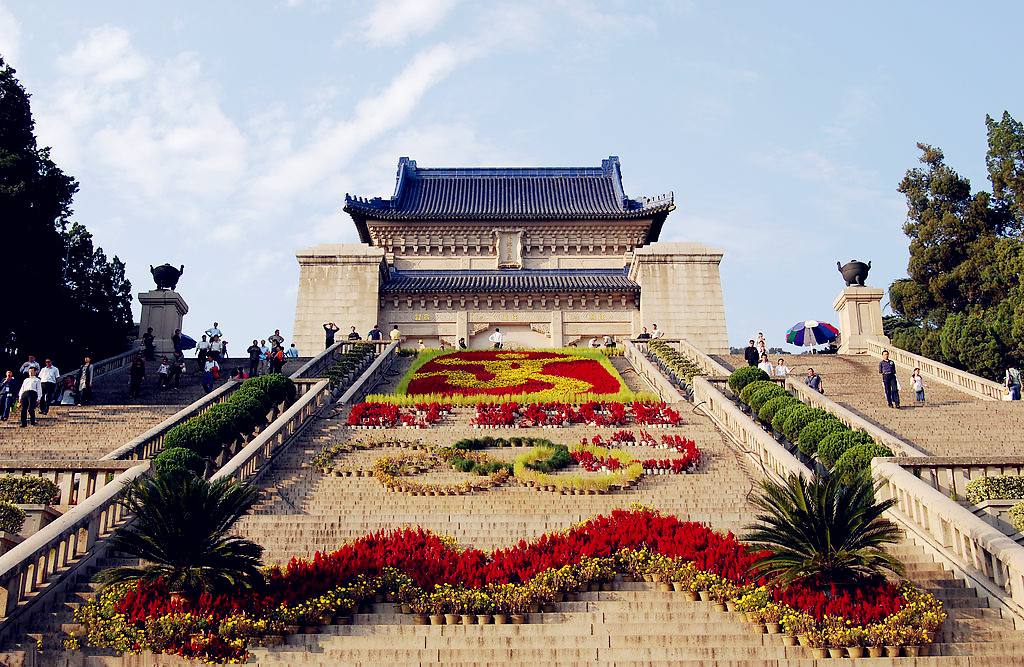
Mausoleum Of Sun Yat-Sen.
Tickets: Prices, Booking, and Tips
When planning your visit to Dr. Sun Yat-sen’s Mausoleum in Nanjing, it’s essential to be well-informed about ticket prices, booking procedures, and additional tips to enhance your experience. Below is a concise overview to guide you:
| Ticket Type | Price (CNY) | Includes |
|---|---|---|
| General Admission | Free | Entrance to the Mausoleum, the Stele Pavilion, the Sacrificial Hall, and the Burial Room. |
| Open-air Music Hall | 10 | Admission to the music hall, featuring various performances. |
| Combo Ticket | 100 | Access to the Open-air Music Hall, Xiaoling Mausoleum of Ming Dynasty, Linggu Temple, and Meiling Palace. |
| Children (under 1.4m) | Free | Entrance to all attractions listed above. |
Booking Information
To ensure a smooth visit, it is highly recommended to book your tickets in advance. Here’s how you can do it:
- Online Booking: You can reserve your tickets through the official website or via WeChat from 7:00 AM to 10:00 PM.
- On-site Booking: If you prefer, you can also use the ticket machines available at the site from 8:00 AM to 5:00 PM on the day of your visit.
Important Note
While entrance to the mausoleum itself is free, securing your tickets ahead of time is vital, especially during peak tourist seasons. This will help you avoid long wait times and ensure you have access to all the attractions you wish to explore.
Additional Tips
- The mausoleum is open from 8:30 AM to 5:00 PM, and it is closed on Mondays (with some exceptions on holidays).
- Consider visiting nearby attractions like Ming Xiaoling Mausoleum and Linggu Temple afterwards, which can be conveniently reached via sightseeing buses or small trains for a nominal fee.
By planning ahead and booking your tickets in advance, you can enrich your visit to this historically significant site and enjoy the breathtaking architecture and serene surroundings that honor one of China’s most revered figures.
How to Get There: A Complete Transportation Guide
From the Nearest Major City
Arriving in Nanjing
By Train:
Nanjing is well-connected to major cities across China, including Shanghai, Beijing, and Guangzhou. The Nanjing Railway Station serves high-speed trains, making it easy to reach the city. For example, a train from Shanghai to Nanjing takes about 1 hour and costs approximately CNY 80-150, depending on the class of service.
By Air:
Nanjing Lukou International Airport (NKG) is the nearest airport, located about 40 km (25 miles) from the city center. From the airport, you can take the Airport Shuttle Bus to the Nanjing South Railway Station, which takes around 50 minutes and costs CNY 30. Alternatively, taxis to the city center range between CNY 150-200.
Getting to Dr. Sun Yat-sen’s Mausoleum
Once in Nanjing, there are several convenient options to reach the Mausoleum:
By Metro:
Take Metro Line 2 and disembark at Xiamafang Station. The mausoleum is approximately a 15-minute walk north from the station. Follow the signs to guide you through the scenic routes of Purple Mountain.
By Bus:
You can catch Bus 34 to Zhongshanling Tingchechang. This bus route is direct and will take you close to the mausoleum entrance. The bus fare is typically CNY 2-3.
By Taxi:
For a more comfortable and direct route, taxis are readily available throughout the city. A taxi ride from the city center to the mausoleum will take about 20-30 minutes and cost around CNY 40-60, depending on traffic.
Getting Around the Scenic Area
Once you arrive at Dr. Sun Yat-sen’s Mausoleum, the scenic area offers several options to explore its beautiful surroundings.
Walking:
The mausoleum complex is quite expansive, covering about 80,000 square meters (20 acres). Walking is highly recommended, as it allows you to fully appreciate the architecture and natural beauty. Be prepared for a bit of a workout, as there are many steps leading up to the main hall.
Sightseeing Train:
For a more leisurely experience, you can take a sightseeing train or battery car that operates within the area. Tickets are usually priced around CNY 10 per person and can save you energy for exploring the attractions like the Open-air Music Hall and Linggu Temple.
Tour Buses:
If you wish to visit other nearby attractions such as the Xiaoling Mausoleum of Ming Dynasty or Linggu Temple, consider using the tourist special line which costs CNY 2 for a single trip. This is a cost-effective way to hop between sites without the hassle of walking long distances.
Bicycles:
Renting a bicycle is another option for those who prefer a more active way to explore the area. Check for rental stations near the entrance of the mausoleum.
Tips for Your Visit
-
Entrance Fees: Admission to the mausoleum itself is free, but visitors must reserve tickets in advance using their passports. The online reservation system operates from 7:00 AM to 10:00 PM, and on-site machines are available from 8:00 AM to 5:00 PM.
-
Timing Your Visit: The mausoleum is open from 8:30 AM to 5:00 PM and is closed on Mondays (except holidays). To avoid crowds, consider visiting early in the morning or late in the afternoon.
-
Nearby Attractions: After your visit, don’t miss the opportunity to explore nearby sites. The Ming Xiaoling Mausoleum and Linggu Temple are both within walking distance and can be accessed via sightseeing buses.
With this guide, your journey to Dr. Sun Yat-sen’s Mausoleum will be smooth and enjoyable, allowing you to immerse yourself in the rich history and stunning architecture of this iconic site.
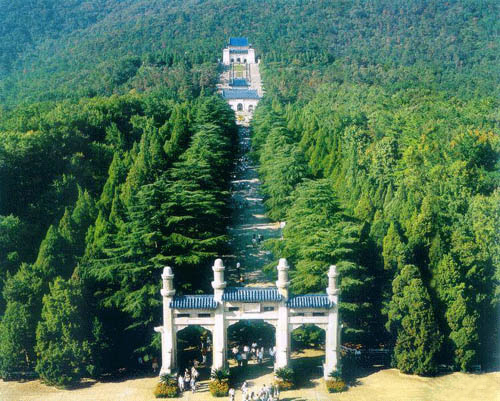
Mausoleum Of Sun Yat-Sen.
Local Cuisine and Accommodation Nearby
Visiting the Mausoleum of Sun Yat-sen is not just a journey into history; it’s also an opportunity to immerse yourself in the vibrant culinary scene and find a comfortable place to stay in Nanjing. Here’s a guide to local cuisine and accommodation options that will enhance your experience.
Local Cuisine
-
Nanjing Salted Duck (盐水鸭)
This iconic dish is a must-try when in Nanjing. The duck is marinated with a blend of salt and spices before being poached, resulting in tender meat and a savory, aromatic flavor. Often served cold, it’s a refreshing dish that pairs beautifully with rice or steamed buns. -
Duck Blood Noodle Soup (鸭血粉丝汤)
A hearty bowl of duck blood noodle soup is a local favorite that combines thin rice noodles with slices of duck blood, tofu, and various vegetables, all simmered in a rich broth. This dish is not only comforting but also showcases the unique flavors of Nanjing’s culinary heritage. -
Pan-Fried Bun (生煎包)
These delightful buns are filled with juicy pork and broth, then pan-fried until crispy on the bottom while remaining soft on top. Often enjoyed as a snack or for breakfast, they’re best dipped in a mixture of soy sauce and vinegar for an extra kick. -
Sweet and Sour Mandarin Fish (糖醋桂鱼)
This dish features a whole fish, typically mandarin fish, deep-fried and then coated in a tangy sweet and sour sauce. The presentation is as impressive as the taste, making it a popular choice for both locals and tourists looking to enjoy Nanjing’s exquisite flavors.
Accommodation Options
Luxury:
– InterContinental Nanjing
Located near the Yangtze River, the InterContinental offers stunning views and luxurious amenities. With elegant rooms, a range of dining options, and a spa, it’s perfect for travelers looking to indulge during their stay.
Boutique:
– The Jinling Hotel Nanjing
This charming hotel combines modern design with traditional Chinese elements. Located close to the city center, it provides easy access to attractions while offering a cozy atmosphere, personalized service, and a delightful on-site restaurant serving local cuisine.
Budget:
– Nanjing 365 Inn
For travelers on a budget, Nanjing 365 Inn offers clean and comfortable accommodations at an affordable price. Situated near public transport, this inn makes it easy to explore Nanjing without breaking the bank. The friendly staff are always ready to assist with local tips and recommendations.
Exploring the rich history and beautiful surroundings of the Mausoleum of Sun Yat-sen is sure to be a highlight of your trip. Pair it with the local flavors of Nanjing and a comfortable place to stay, and you’ll create lasting memories of your journey in this vibrant city.
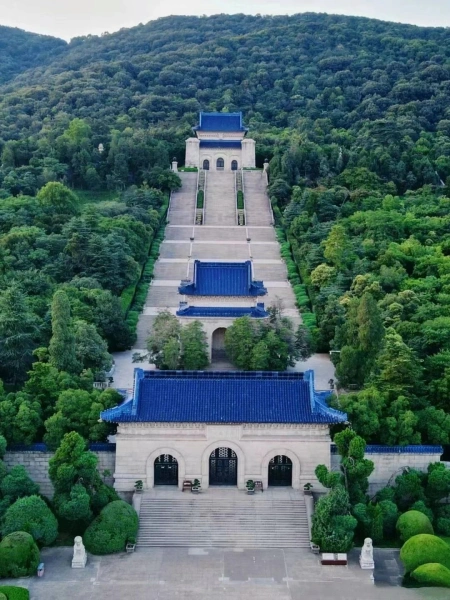
Mausoleum Of Sun Yat-Sen.
Frequently Asked Questions
Frequently Asked Questions
1. Is the Mausoleum suitable for children and the elderly?
Yes, the Mausoleum is accessible for both children and the elderly. However, keep in mind that there are several stairs to climb, particularly to reach the Sacrificial Hall. Families with young children or elderly visitors should consider taking breaks and pacing themselves during the visit.
2. Are there English signs and information available?
Yes, there are English signs throughout the Mausoleum, providing information about the various structures and their historical significance. Additionally, brochures and guides in English may be available at the entrance.
3. How much time should I plan for a visit?
Plan to spend around 2 to 3 hours at the Mausoleum to fully appreciate the architecture, walk the grounds, and explore the surrounding memorial buildings. This timing allows for leisurely exploration and photography.
4. Is there an entrance fee?
Entry to the Mausoleum is free, but visitors must book tickets in advance using their passports. Tickets can be reserved online or at on-site machines. Note that the Open-air Music Hall charges a small fee of CNY 10.
5. What are the opening hours?
The Mausoleum is open daily from 8:30 AM to 5:00 PM but is closed on Mondays, except during holidays. The Burial Room is also closed on weekends, so plan your visit accordingly.
6. How do I get to the Mausoleum?
You can reach the Mausoleum by taking Metro Line 2 and getting off at Xiamafang Station, followed by a 15-minute walk north. Alternatively, you can take bus number 34 to Zhongshanling Tingchechang.
7. Are there any nearby attractions to visit?
Absolutely! After visiting the Mausoleum, consider exploring nearby attractions such as the Ming Xiaoling Mausoleum and Linggu Temple. Sightseeing buses and small trains are available for easy transport between these sites.
8. Is there food and drink available on-site?
While there are no food vendors directly at the Mausoleum, you can find various dining options in the surrounding area. It’s advisable to bring water and light snacks, especially if you plan to spend a few hours exploring the grounds.
Final Thoughts on Your Trip
As you conclude your visit to the Mausoleum of Sun Yat-sen, take a moment to reflect on the profound historical significance and architectural beauty that surrounds you. This majestic site, nestled in the lush embrace of Purple Mountain, is not just a resting place for a revered leader but a symbol of resilience and hope for the people of China.
Walking along the marble pathway lined with towering cypress trees, you’ll find yourself immersed in the legacy of Dr. Sun Yat-sen, the father of modern China. The tranquil atmosphere combined with the stunning views from the Sacrificial Hall creates a deeply moving experience that resonates with visitors from around the world.
As you prepare to leave this sacred ground, remember that the spirit of Dr. Sun Yat-sen continues to inspire countless individuals in their pursuit of freedom and democracy. Let his story encourage you to carry forward the values of courage and determination in your own life. Whether you’re exploring more of Nanjing’s rich history or journeying to new destinations, may your travels be filled with discovery and inspiration, just as they are at this remarkable mausoleum.